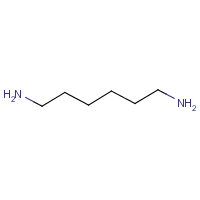1,6-Diaminohexane
Agent Name
1,6-Diaminohexane
Alternative Name
Hexamethylenediamine
CAS Number
124-09-4
Formula
C6-H16-N2
Major Category
Nitrogen Compounds

Synonyms
Hexamethylenediamine; 1,6-Diamino-n-hexane; 1,6-Diaminohexane; 1,6-Hexamethylenediamine; 1,6-Hexanediamine; 1,6-Hexanediamine (solution); 1,6-Hexylenediamine; HMDA; Hexane, 1,6-diamino-; [ChemIDplus] UN1783(solution); UN2280(solid)
Category
Amines, Aliphatic
Description
Colorless solid; [Hawley] Hygroscopic; [ICSC] Has an ammonia-like or fishy odor; [CHEMINFO] White solid; [MSDSonline]
Sources/Uses
Used as an intermediate to make polyamides with applications in fiber, plastics, polyurethane coatings and adhesives, specialty nylons (monofilaments and inks), and specialty chemicals (biocides, petroleum additives, and phenol purification); [eChemPortal: SIDSUNEP]
Comments
A corrosive substance that can cause injury to the skin, eyes, and respiratory tract; Inhalation of high concentrations may cause pulmonary edema; [ICSC] Allergic dermatitis, rhinitis, and asthma were reported in exposed workers. One case of acute hepatitis was reported. In animal experiments, 6 guinea pigs receiving orally 0.02 grams/day for 20-95 days are slowly poisoned and have weight loss, hemolytic anemia, leukopenia, liver damage, and kidney damage; Similar effects are seen in high-dose inhalation studies in rats inhaling 1.25 mg/m3 (0.26 ppm) 4 hours per day for 8 days; [HSDB] Exposed workers complain of skin and respiratory tract irritation; [ACGIH] Does not meet criteria for dermal sensitizer since animal studies were negative and human reports not confirmed; [AIHA] A corrosive substance that can cause injury to the skin, eyes, and respiratory tract; [MSDSonline]
Biomedical References
Exposure Assessment
Skin Designation (ACGIH)
Insufficient data
TLV (ACGIH)
0.5 ppm
Vapor Pressure
0.4 mm Hg
Lethal Concentration
LC (rat) > 200 ppm/4h
Explanatory Notes
Flash point = 85 deg C; [ICSC]
WEEL
1 ppm
Adverse Effects
Anemia
Hemolytic anemia
Toxic Pneumonitis
Yes
Hepatotoxin
Hepatoxic (a) from occupational exposure (secondary effect) or (b) in animal studies or in humans after ingestion
Dermatotoxin
Skin burns
Diseases, Processes, and Activities Linked to This Agent
Other Information
No other related information on this agent was found.